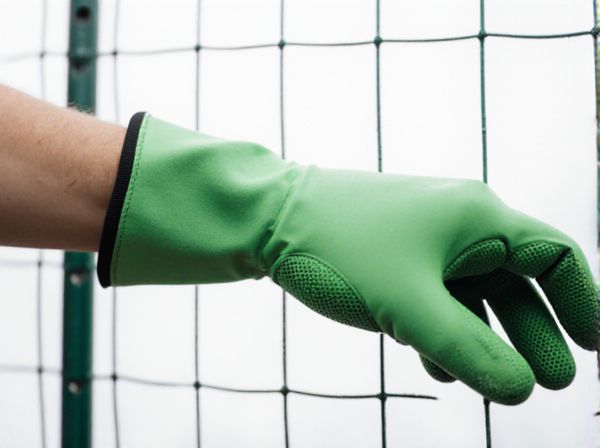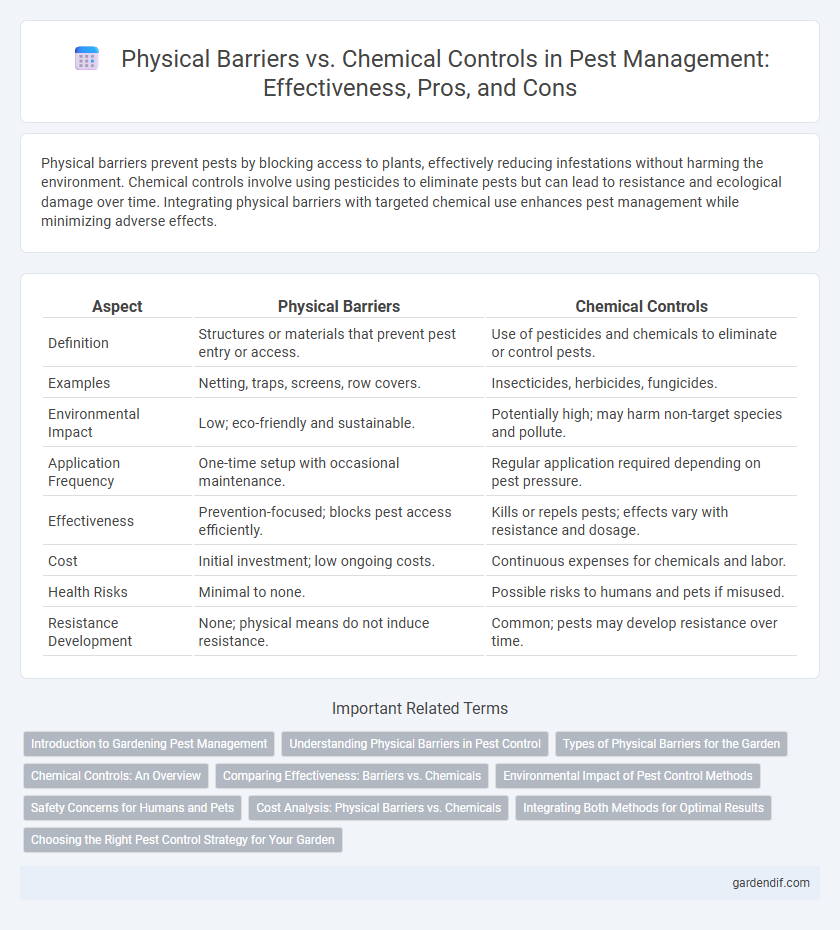
Physical barriers vs chemical controls Illustration
Physical barriers prevent pests by blocking access to plants, effectively reducing infestations without harming the environment. Chemical controls involve using pesticides to eliminate pests but can lead to resistance and ecological damage over time. Integrating physical barriers with targeted chemical use enhances pest management while minimizing adverse effects.
Table of Comparison
| Aspect | Physical Barriers | Chemical Controls |
|---|---|---|
| Definition | Structures or materials that prevent pest entry or access. | Use of pesticides and chemicals to eliminate or control pests. |
| Examples | Netting, traps, screens, row covers. | Insecticides, herbicides, fungicides. |
| Environmental Impact | Low; eco-friendly and sustainable. | Potentially high; may harm non-target species and pollute. |
| Application Frequency | One-time setup with occasional maintenance. | Regular application required depending on pest pressure. |
| Effectiveness | Prevention-focused; blocks pest access efficiently. | Kills or repels pests; effects vary with resistance and dosage. |
| Cost | Initial investment; low ongoing costs. | Continuous expenses for chemicals and labor. |
| Health Risks | Minimal to none. | Possible risks to humans and pets if misused. |
| Resistance Development | None; physical means do not induce resistance. | Common; pests may develop resistance over time. |
Introduction to Gardening Pest Management
Physical barriers such as row covers, nets, and collars prevent pests from reaching plants by creating a protective shield that disrupts their access and feeding. Chemical controls, including insecticides and fungicides, target pest populations directly through toxic substances but require careful application to minimize environmental impact and resistance development. Integrating physical barriers with selective chemical use forms the foundation of sustainable gardening pest management by balancing efficacy and ecological health.
Understanding Physical Barriers in Pest Control
Physical barriers in pest control, such as screens, nets, and row covers, effectively prevent pests from reaching plants by creating a protective shield. These barriers reduce the need for chemical pesticides, lowering environmental impact and minimizing pesticide resistance among pest populations. Proper installation and maintenance of physical barriers ensure long-term pest exclusion and promote sustainable agricultural practices.
Types of Physical Barriers for the Garden
Types of physical barriers for the garden include row covers, garden fabric, and insect netting, which prevent pest access without the use of chemicals. Wire mesh and copper tape effectively deter slugs, snails, and larger animals from reaching plants. These barriers create a protective environment that reduces pest damage while maintaining eco-friendly and chemical-free gardening practices.
Chemical Controls: An Overview
Chemical controls in pest management involve the application of pesticides such as insecticides, herbicides, and fungicides to target specific pests and reduce their populations effectively. These chemicals disrupt biological processes in pests, providing rapid action and high efficacy compared to physical barriers, which rely on deterrence or exclusion methods. Advances in integrated pest management promote selective and environmentally safer chemical formulations to minimize non-target effects and resistance development.
Comparing Effectiveness: Barriers vs. Chemicals
Physical barriers such as nets and row covers provide a non-toxic method to prevent pest entry, offering long-term protection without the risk of chemical resistance. Chemical controls, including insecticides and pesticides, act quickly to eradicate existing infestations but may cause environmental harm and promote resistant pest populations. Effectiveness depends on pest type, infestation severity, and crop sensitivity, with integrated pest management often combining both for optimal results.
Environmental Impact of Pest Control Methods
Physical barriers in pest control minimize environmental impact by preventing pest entry without introducing toxic substances, preserving soil and water quality. Chemical controls often lead to contamination of ecosystems, harming non-target organisms like pollinators and aquatic life due to pesticide runoff and residue. Sustainable pest management favors physical barriers to reduce ecological disruption and support biodiversity conservation.
Safety Concerns for Humans and Pets
Physical barriers offer a safer alternative to chemical controls by minimizing exposure to toxic substances harmful to humans and pets. Unlike pesticides, these barriers do not release harmful residues, reducing the risk of allergic reactions, poisoning, or long-term health effects. Employing physical methods such as screens, traps, and sealed entry points ensures effective pest management with a significantly lower safety risk.
Cost Analysis: Physical Barriers vs. Chemicals
Physical barriers for pest control often require higher initial investment due to materials and installation but offer long-term savings with minimal environmental impact and reduced chemical use. Chemical controls typically involve lower upfront costs but can accumulate expenses over time through repeated applications, resistance development, and potential environmental damage remediation. Evaluating cost-effectiveness favors physical barriers in sustainable pest management, especially in agricultural and residential settings seeking eco-friendly solutions.
Integrating Both Methods for Optimal Results
Integrating physical barriers and chemical controls enhances pest management efficacy by combining the strengths of exclusion techniques, such as nets and traps, with targeted pesticide applications. This integrated approach minimizes pesticide use while maximizing pest suppression, reducing environmental impact and resistance development. Employing both methods strategically leads to sustainable pest control and improved crop protection outcomes.
Choosing the Right Pest Control Strategy for Your Garden
Physical barriers like row covers and mulch effectively prevent pests by blocking access to plants, reducing reliance on chemical interventions. Chemical controls, such as insecticides and herbicides, target specific pests but require careful selection to minimize environmental impact and avoid harming beneficial insects. Combining physical barriers with targeted chemical use enhances pest management while promoting a healthier, more balanced garden ecosystem.
Physical barriers vs chemical controls Infographic

 gardendif.com
gardendif.com